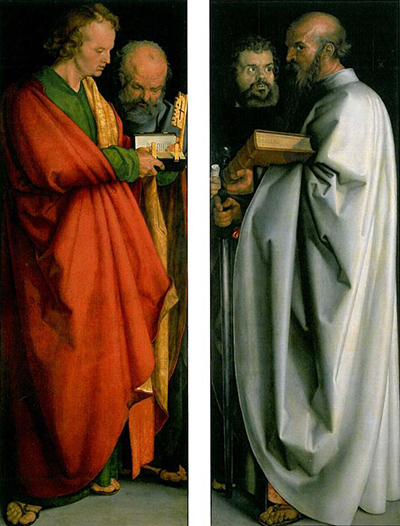The Four Apostles was a powerful political statement from Albrecht Durer during a time of turbulence and social unrest within Northern Europe
The Reformation would make a huge impact on the balance of western Christianity and it was impossible not to be caught up in the ramifications that followed. The changes took place from the the publication of the Ninety-five Theses by Martin Luther in 1517 right up until the end of the Thirty Years' War in 1648.
One impact on Durer was that it would dry up his commissions from the Christian Church. He would need to come up with his own commissions from this point. The Reformation itself had the biggest impact on Germany and there are elements of The Four Apostles by Albrecht Durer that appear related to this change in society.
The religious theme is continued with texts added by the artist to the foot of each panel. Durer inscribed passages from the Bible onto this oil on lindenwood series of two. This huge set of paintings is over two metres long, clearly even above lifesize. Durer himself had produced Germany's first nude lifesize portrait with Adam and Eve.
Durer produced many key paintings after his move back to Nuremburg, including The Four Apostles found here. It is for this reason that the city continues to try to bring this painting back to the city but it remains stubbornly in Munch, at the Alte Pinakothek.
This art museum holds an outstanding collection of North European art, particularly from the Renaissance period. Paumgartner Altar, Self-portrait in Fur Coat are two other Albrecht Durer paintings that are to be found here. You will also find work in their collection from other notable Germans such as Matthias Grünewald, Hans Holbein, Lucas Cranach the Elder, Albrecht Altdorfer and Stefan Lochner. Dutch and Netherlandish artists found here include Hieronymus Bosch, Hans Memling, Rembrandt van Rijn, Frans Hals and Jacob van Ruisdael.
Their collection from the 16th to 18th centuries is spearheaded by one of the most impressive collections of Peter Paul Rubens paintings in the world. In truth, there is so much to include here that we won't even touch on their large sections of Italian, French and Spanish art.




